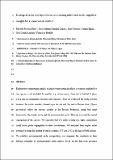Por favor, use este identificador para citar o enlazar a este item:
http://hdl.handle.net/10261/216657COMPARTIR / EXPORTAR:
 SHARE SHARE
 CORE
BASE CORE
BASE
|
|
| Visualizar otros formatos: MARC | Dublin Core | RDF | ORE | MODS | METS | DIDL | DATACITE | |

| Campo DC | Valor | Lengua/Idioma |
|---|---|---|
| dc.contributor.author | Pascual Rico, Roberto | - |
| dc.contributor.author | Sánchez-Zapata, José A. | - |
| dc.contributor.author | Navarro, Joan | - |
| dc.contributor.author | Eguía, Sergio | - |
| dc.contributor.author | Anadón, José D. | - |
| dc.contributor.author | Botella, Francisco | - |
| dc.date.accessioned | 2020-07-15T08:50:09Z | - |
| dc.date.available | 2020-07-15T08:50:09Z | - |
| dc.date.issued | 2020-04 | - |
| dc.identifier | issn: 1387-3547 | - |
| dc.identifier | issn: 1573-1464 | - |
| dc.identifier.citation | Biological Invasions 22: 2497–2508 (2020) | - |
| dc.identifier.other | CEX2019-000928-S | - |
| dc.identifier.uri | http://hdl.handle.net/10261/216657 | - |
| dc.description | 12 pages, 5 figures, 1 table, supplementary material https://doi.org/10.1007/s10530-020-02265-x | - |
| dc.description.abstract | Exploitative competition implies an indirect interaction in which a resource exploited by one species is not available for another; e.g., when species share diet or habitat. It plays a key role in community structure and dynamics. Here we evaluated the niche overlap between the exotic aoudad (Ammotragus lervia) and the native Iberian ibex (Capra pyrenaica) where the species coexist in the Iberian Peninsula, along two main dimensions, the trophic niche and the environmental niche. Then we assessed the spatial segregation of the species. We expected that if a niche overlap was high, competition could drive spatial segregation to allow co-existence. We analyzed their trophic niche overlap by using the content of stable isotopes δN and δC in the hair of both species. To establish environmental niche competition, we compared the similarity in their habitat, estimated by environmental niche models based on the fine-scale presence records of each species obtained from field surveys. To test if spatial segregation occurred, we analyzed both species’ co-occurrence. Our results indicated that both species shared a similar trophic niche measured by stable isotopes, both species showed a similar distribution of suitable areas, and that both species’ environmental niches were more similar than expected. Finally, a negative spatial association was found between the aoudad and Iberian ibex. These results reveal that both species are ecologically similar and suggest that fine-scale spatial segregation might have favoured their co-existence in semiarid Mediterranean mountains. Our results show that integrating information on trophic and environmental niche overlap with fine scale spatial distribution might improve the study of competitive interactions among wild ungulates | - |
| dc.description.sponsorship | RPR was supported by a pre-doctoral grant from the Spanish Ministry of Education (FPU13/05460). JN was funded by the Spanish National Program Ramón y Cajal (RYC-2015-17809). The study was partially supported by MICINM and ERDF (project "TRASCAR” RTI2018-099609-B-C21) | - |
| dc.description.sponsorship | With the funding support of the ‘Severo Ochoa Centre of Excellence’ accreditation (CEX2019-000928-S), of the Spanish Research Agency (AEI) | - |
| dc.language | eng | - |
| dc.publisher | Springer Nature | - |
| dc.relation | info:eu-repo/grantAgreement/AEI/Plan Estatal de Investigación Científica y Técnica y de Innovación 2017-2020/RTI2018-099609-B-C21 | - |
| dc.relation.isversionof | Preprint | - |
| dc.rights | openAccess | - |
| dc.subject | Ammotragus | - |
| dc.subject | Assisted colonization | - |
| dc.subject | Capra | - |
| dc.subject | Competition | - |
| dc.subject | Environmental model | - |
| dc.subject | Stable isotopes | - |
| dc.title | Ecological niche overlap between co-occurring native and exotic ungulates: insights for a conservation conflict | - |
| dc.type | artículo | - |
| dc.identifier.doi | 10.1007/s10530-020-02265-x | - |
| dc.relation.publisherversion | https://doi.org/10.1007/s10530-020-02265-x | - |
| dc.date.updated | 2020-07-15T08:50:10Z | - |
| dc.rights.license | https://www.springer.com/gp/open-access/publication-policies/self-archiving-policy | - |
| dc.contributor.funder | Ministerio de Educación (España) | - |
| dc.contributor.funder | Ministerio de Ciencia, Innovación y Universidades (España) | - |
| dc.contributor.funder | Agencia Estatal de Investigación (España) | - |
| dc.relation.csic | Sí | - |
| dc.identifier.funder | http://dx.doi.org/10.13039/501100011033 | es_ES |
| dc.type.coar | http://purl.org/coar/resource_type/c_6501 | es_ES |
| item.openairetype | artículo | - |
| item.grantfulltext | open | - |
| item.cerifentitytype | Publications | - |
| item.openairecristype | http://purl.org/coar/resource_type/c_18cf | - |
| item.fulltext | With Fulltext | - |
| Aparece en las colecciones: | (ICM) Artículos | |
Ficheros en este ítem:
| Fichero | Descripción | Tamaño | Formato | |
|---|---|---|---|---|
| Pascual_Rico_et_al_2020_preprint.pdf | 900,77 kB | Adobe PDF |  Visualizar/Abrir | |
| Pascual_Rico_et_al_2020_suppl.docx | 22,3 kB | Microsoft Word XML | Visualizar/Abrir | |
| Pascual_Rico_et_al_2020_preprint.docx | 2,13 MB | Microsoft Word XML | Visualizar/Abrir |
CORE Recommender
SCOPUSTM
Citations
19
checked on 13-abr-2024
WEB OF SCIENCETM
Citations
16
checked on 26-feb-2024
Page view(s)
200
checked on 19-abr-2024
Download(s)
470
checked on 19-abr-2024
Google ScholarTM
Check
Altmetric
Altmetric
NOTA: Los ítems de Digital.CSIC están protegidos por copyright, con todos los derechos reservados, a menos que se indique lo contrario.
